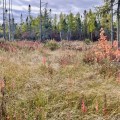Ella Katona is a student at Kent State University and one of 10 Pittsburgh Media Partnership 2024 summer interns.
This story is part of our series, Wild Pennsylvania. Check out all of our stories here.
A new law requires the Pennsylvania Department of Transportation to plant native vegetation along state highways. PennDOT must select native plants that will thrive in plant hardiness zones and under environmental conditions along highways.
Andrea Ferich, President of the Pennsylvania Native Plant Society, says native plants will cost less for PennDOT to manage.
Currently, many Pennsylvania highways have miles of grass to mow and invasive plant species, such as barberry and Callery pear, to manage.
Once native plants get established, Ferich explains that it will allow for better erosion control and soil health along state highways.
“They require little maintenance,” she said. “With their extensive root systems, [native plants] help to prevent flooding and reduces [the need for] mowing.”
Native plants also require little watering, pruning, or deadheading.
Collaborative efforts
Ferich and her group at the PA Native Plant Society would like to help PennDOT develop a list of recommended species to plant along our highways, such as black-eyed Susans, bee balms, asters and goldenrods.
“Native plants have co-evolved with both native pollinators and seed dispersers such as birds and butterflies, moths and bats,” Ferich said. “Many pollinators rely solely on the native plants for food, shelter and reproduction.”
Leading up to the Senate vote on the bill, PA Native Plant Society partnered with the Chesapeake Bay Foundation to put an action alert on their websites that viewers could sign in support of the bill. It passed 45-2 and was signed by Governor Josh Shapiro on July 1.
According to the Chesapeake Bay Foundation, their digital campaign had 2,366 individuals across the Commonwealth of Pennsylvania send 2,507 letters to members of the state legislature in support of the bill.
“We want communities of people to understand that they can make a difference,” Ferich said. “We’re excited to see the highways move from sterile landscapes into thriving, ecological and rich sources of food and nutrition for our native pollinators.”




